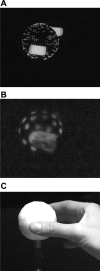Lack of depth constancy for grasping movements in both virtual and real environments
- PMID: 26269553
- PMCID: PMC4600967
- DOI: 10.1152/jn.00350.2015
Lack of depth constancy for grasping movements in both virtual and real environments
Abstract
Recent studies on visuomotor processes using virtual setups have suggested that actions are affected by similar biases as perceptual tasks. In particular, a strong lack of depth constancy is revealed, resembling biases in perceptual estimates of relative depth. With this study we aim to understand whether these findings are mostly caused by a lack of metric accuracy of the visuomotor system or by the limited cues provided by the use of virtual reality. We addressed this issue by comparing grasping movements towards a spherical object located at four distances (420, 450, 480, and 510 mm) performed in three conditions: 1) virtual, in which the target was a virtual object defined by binocular cues, 2) glow-in-the-dark, in which the object was painted with luminous paint but no other cue was provided, and 3) full-cue, in which the movement was performed with the lights on and all the environmental information was available. Results revealed a striking effect of object distance on grip aperture equally in all three conditions. Specifically, grip aperture gradually decreased with increase in object distance, proving a consistent lack of depth constancy. These findings clearly demonstrate that systematic biases in grasping actions are not induced by the use of virtual environments and that action and perception may involve the same visual information, which does not engage a metric reconstruction of the scene.
Keywords: 3D; depth constancy; grasping; virtual reality; visuomotor control.
Copyright © 2015 the American Physiological Society.
Figures





References
-
- Aglioti S, DeSouza JF, Goodale MA. Size-contrast illusions deceive the eye but not the hand. Curr Biol 5: 679–685, 1995. - PubMed
-
- Bingham GP, Zaal F, Robin D, Shull JA. Distortions in definite distance and shape perception as measured by reaching without and with haptic feedback. J Exp Psychol Hum Percept Perform 26: 1436–1460, 2000. - PubMed
-
- Bingham GP, Bradley A, Bailey M, Vinner R. Accommodation, occlusion, and disparity matching are used to guide reaching: a comparison of actual versus virtual environments. J Exp Psychol Hum Percept Perform 27: 1314–1334, 2001. - PubMed
-
- Bingham G, Coats R, Mon-Williams M. Natural prehension in trials without haptic feedback but only when calibration is allowed. Neuropsychologia 45: 288–294, 2007. - PubMed
-
- Bozzacchi C, Volcic R, Domini F. Effect of visual and haptic feedback on grasping movements. J Neurophysiol 112: 3189–3196, 2014. - PubMed
MeSH terms
LinkOut - more resources
Full Text Sources
Other Literature Sources

